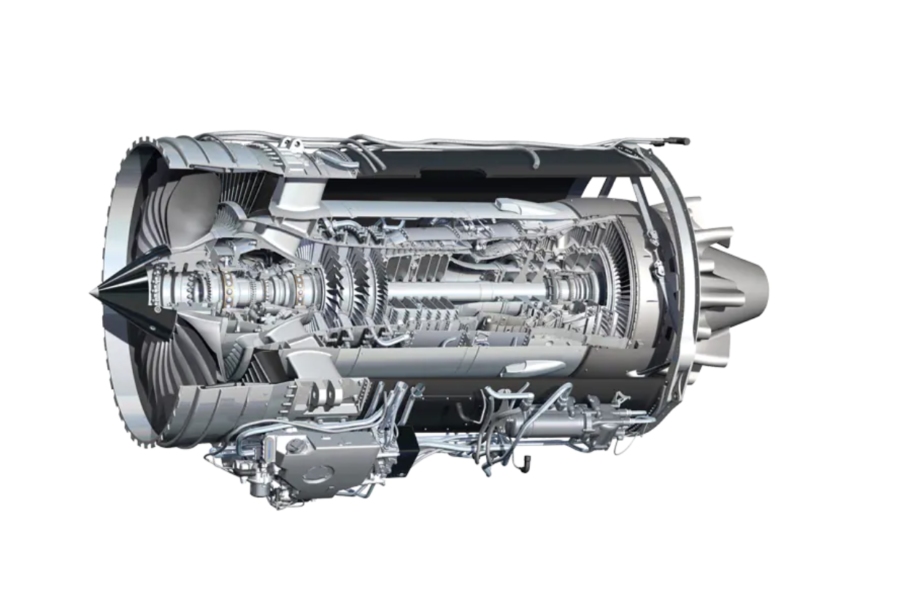The Air Force has selected Rolls-Royce North America as its contractor for the B-52 Commercial Engine Replacement Program, or CERP, which will supply new F130 powerplants for all 76 of Air Force Global Strike Command’s B-52H bombers, the Pentagon announced Sep. 24. If all options are exercised, the work is worth $2.6 billion.
The F130 engine is flying on the C-37 transport and E-11 BACN (Battlefield Airborne Communications Node) aircraft. The first part of the indefinite quantity-indefinite delivery contract is worth $500.9 million. The contract calls for Rolls to supply 608 engines, to equip 76 B-52s with eight engines each, with manufacture and installation to be completed by Sept. 23, 2038. Rolls said the actual number of powerplants, including spares, is 650.
The Air Force did not say when the installs will begin. The engines will be built at Rolls’s Indianapolis, Ind., facilities, where the company said it has invested $600 million in an “advanced manufacturing campus.” The work will require 150 new hires, the company said. The contract value is substantially below initial estimates, which ran as much as $10 billion for the CERP.
The Air Force said it received four proposals for the competitive contract, which also calls for spare engines, associated support gear, commercial engineering data, and “sustainment activities,” the Pentagon said.
The CERP competition has been underway since 2018 and has been a three-way contest among GE Aviation, Pratt & Whitney, and Rolls-Royce. The Air Force pioneered a number of “digital” firsts on the program, insisting on a paperless proposal in which the competitors’ engines would duke it out on computers. The service also insisted on access to tech data such that it could compete future work on the program among other companies.
“This is a major win for Rolls-Royce,” said Craig McVay, company senior vice president, strategic campaigns. “We’ve been planning and preparing for this outcome and are ready to hit the ground running to prove that we are the best choice for the Air Force and the B-52.”
The CERP is one aspect of a multi-pronged update of the B-52, which is also slated to receive a new radar, digital cockpit, and new connectivity upgrades. The Air Force plans to retain the B-52 into the 2050s, as a standoff weapon platform and as a direct attack aircraft when enemy defenses are limited or already beaten down. The last B-52H now in service was built in 1962, but the type is still flying with its original Pratt & Whitney TF33 engines. Early in the program, Pratt proposed an upgrade of the TF33, which the Air Force rejected.
The CERP is supposed to deliver up to 40 percent improved range and fuel economy for the B-52, reducing its tanker requirements and increasing its on-station loiter time. The engine is also supposed to be of such improved reliability that the engines need never come off the wing during the bomber’s remaining service life.
Senior USAF acquisition officials at AFA’s Air, Space & Cyber ’21 conference said the CERP contract award was “imminent.” Acting Air Force acquisition executive Darlene Costello said the CERP would likely be converted into a USAF major acquisition program given its scope and value.
Boeing, the original builder of the B-52, will integrate the engines, radar, and other new systems onto the bomber but did not play a role in selecting the winner of the CERP competition. A Boeing official said the company provided data to the Air Force on the relative ease or difficulty of integrating each of the competing powerplants but did not make a recommendation on which one should be selected. Boeing will decide whether and how to mount the engines in twin-engine pods or nacelles, as the TF33s are now arranged, and will do the necessary aerodynamic calculations as to the placement of the engines for optimum performance and least interference with the aerodynamic structure. A Boeing official said the B-52’s disused nose-mounted infrared pods will likely be removed to improve airflow at the front of the bomber.
